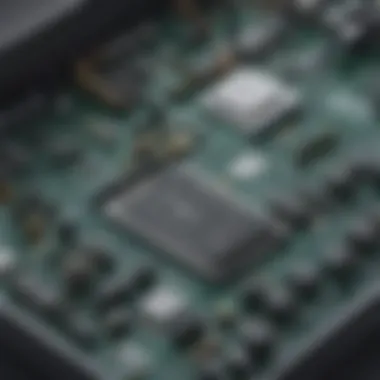Unveiling the Comprehensive Guide to Altium Designer Free Software Tool


Software Overview
Altium Designer Free is a cutting-edge software tool pivotal for electronic design automation. This section will delineate an encompassing introduction to the software, expounding on its key features and functionalities, as well as shedding light on its pricing plans and available subscriptions. Understanding these aspects is crucial for businesses, entrepreneurs, and IT professionals aiming to maximize their electronic design projects' efficiency and cost-effectiveness.
User Experience
In this segment, the discussion will revolve around the user experience offered by Altium Designer Free. It will delve into the software's user interface and navigational elements, assessing their intuitiveness and accessibility. Furthermore, the section will explore the software's ease of use and learning curve, providing invaluable insights for professionals looking to optimize their design processes. Customer support options and reliability will also be scrutinized, addressing the crucial aspect of support availability in ensuring seamless operations.
Performance and Reliability
Unveiling the performance and reliability metrics of Altium Designer Free is indispensable for prospective users seeking to gauge its effectiveness. This part will evaluate the software's speed and efficiency, examining how it streamlines the electronic design process. Additionally, uptime and downtime statistics will be analyzed to assess the software's operational stability. Moreover, the section will probe into the software's integration capabilities with other tools, offering a comprehensive view of its compatibility and versatility.
Security and Compliance
Security and compliance hold paramount importance in the realm of electronic design software. This section will scrutinize Altium Designer Free's data encryption and security protocols, crucial for safeguarding sensitive project information. Furthermore, the software's compliance with industry regulations will be discussed, ensuring that users adhere to requisite standards. Backup and disaster recovery measures will also be explored, underlining the software's commitment to data integrity and continuity.
Introduction
In the realm of electronic design automation, Altium Designer Free emerges as a prominent software tool with a multitude of functionalities and applications. This article aims to delve deep into the nuances of Altium Designer Free, unraveling its intricacies and shedding light on its significance within the domain of electronic design. Understanding the core essence of Altium Designer Free is pivotal for aspiring designers and seasoned professionals alike, as it paves the way for efficient, streamlined electronic design processes.
What is Altium Designer Free?


Altium Designer Free stands out as a robust software solution tailored for electronic design tasks, offering a wide array of features and tools that facilitate schematic design, PCB layout, component libraries management, and simulation tools. This software serves as a cornerstone for designers to translate their conceptual ideas into tangible electronic designs, bridging the gap between imagination and implementation seamlessly.
Purpose of the Guide
The purpose of this comprehensive guide is to provide a roadmap for users navigating the realm of Altium Designer Free. By elucidating the features, benefits, and limitations of this software, this guide equips users with the necessary knowledge to leverage Altium Designer Free effectively in their electronic design endeavors. Additionally, this guide aims to compare Altium Designer Free with paid versions, offering insights into feature disparities and upgrade options, aiding users in making informed decisions regarding their choice of design software.
Key Features of Altium Designer Free
When delving into the realm of Altium Designer Free, understanding its key features is paramount. These features serve as the backbone of the software, providing users with a robust set of tools to streamline their electronic design automation processes. From schematic design to PCB layout, component libraries, simulation tools, and collaboration features, Altium Designer Free offers a comprehensive suite of functionalities.
Schematic Design
In the domain of electronic design, the schematic serves as a visual representation of the circuit. Altium Designer Free excels in this aspect by providing users with a user-friendly interface to create and customize schematics efficiently. The software offers a wide range of components and symbols, ensuring versatility and flexibility in schematic design. With Altium Designer Free, users can seamlessly translate their circuit concepts into tangible designs.
PCB Layout
The PCB layout is pivotal in transforming circuit schematics into physical boards. Altium Designer Free equips users with sophisticated tools for designing and optimizing PCB layouts. Through intuitive features like routing capabilities, design rule checks, and layer stack management, users can create intricate PCB layouts with precision and efficiency. Altium Designer Free empowers users to bring their circuit designs to life through meticulously crafted PCB layouts.
Component Libraries
Central to efficient electronic design is access to a vast library of components. Altium Designer Free offers a rich repository of components that spans diverse categories, enabling users to expedite the design process. By leveraging pre-existing component libraries, users can accelerate prototyping and iterate designs swiftly. The comprehensive component libraries within Altium Designer Free enhance productivity and facilitate seamless integration of components into designs.
Simulation Tools


Simulation plays a pivotal role in validating circuit designs before physical implementation. Altium Designer Free features robust simulation tools that enable users to analyze and optimize their designs virtually. Through simulations, users can assess factors like signal integrity, power distribution, and thermal management, ensuring the reliability and efficiency of their designs. The simulation tools in Altium Designer Free empower users to refine their designs iteratively, enhancing overall design quality.
Collaboration Features
Collaboration is essential in modern design environments, fostering teamwork and enhancing project outcomes. Altium Designer Free offers a suite of collaboration features that facilitate seamless communication and project management among team members. With features like real-time sharing, version control, and comment functionalities, Altium Designer Free ensures effective collaboration across distributed teams. By promoting communication and enhancing visibility, the collaboration features in Altium Designer Free streamline the design process and drive project success.
Using Altium Designer Free
In the exploration of Altium Designer Free, one cannot overlook the pivotal aspect of utilizing this software to its fullest potential. Understanding the ins and outs of using Altium Designer Free is crucial for small to medium-sized businesses, entrepreneurs, and IT professionals aiming to streamline their electronic design automation processes. This section delves deep into the intricacies of navigating Altium Designer Free to harness its robust features effectively.
Installation and Setup
A critical juncture in the journey of adopting Altium Designer Free is the installation and setup process. This phase demands meticulous attention to detail as it lays the foundation for a seamless experience with the software. Entrepreneurs and IT professionals embarking on this endeavor need to grasp the technical requirements and system configurations essential for the smooth deployment of Altium Designer Free. Clear and concise instructions on downloading, installing, and configuring the software are key to a successful initiation into the realm of electronic design automation.
Interface Overview
Upon successful installation, users are greeted with the interface of Altium Designer Free, a gateway to a plethora of design tools and capabilities. Navigating this interface efficiently is paramount for maximizing productivity and efficiency in electronic design projects. Understanding the layout, toolbars, panels, and workflows embedded within the interface is vital for seamless operation. Entrepreneurs, in particular, need to familiarize themselves with the user-friendly interface to expedite design processes and bring innovative ideas to fruition.
Basic Design Process
The heart of Altium Designer Free lies in its capacity to facilitate the basic design process with precision and ease. From schematic design to PCB layout, this software offers a comprehensive toolkit for translating concepts into tangible circuit designs. Entrepreneurs and IT professionals can leverage the integrated design features to conceptualize, simulate, and finalize electronic designs efficiently. A step-by-step guide to the basic design process equips users with the knowledge and proficiency to execute projects with accuracy and proficiency.


Tips and Tricks
As with any advanced software tool, mastering Altium Designer Free requires a nuanced understanding of its capabilities and shortcuts. Tips and tricks curated for optimizing workflow, troubleshooting common issues, and enhancing design efficiency are invaluable for entrepreneurs and IT professionals seeking to elevate their electronic design endeavors. By harnessing these insider tips, users can navigate complex design challenges, expedite project timelines, and unlock the full potential of Altium Designer Free.
Comparing Altium Designer Free to Paid Versions
The comparison between Altium Designer Free and its paid versions holds significant importance in this comprehensive guide. Understanding the distinctions between the free and paid versions is crucial for users to make informed decisions about their electronic design projects. By delving into the feature disparities, usability enhancements, and support differences between the two versions, users can gauge whether investing in the premium editions aligns with their project requirements and budget considerations.
Feature Variations
Detailing the feature variations between Altium Designer Free and the paid editions sheds light on the unique functionalities each version offers. While the free version provides essential tools for schematic design and PCB layout, the paid versions tend to offer advanced features such as multi-layer board support, signal integrity analysis, and high-speed design capabilities. By examining these distinctions, users can assess whether the additional features in the paid versions justify the upgrade cost for their specific projects.
Limitations of the Free Version
Exploring the limitations of the free version of Altium Designer is vital for users to manage their expectations effectively. The free edition typically imposes constraints on the number of schematic sheets, PCB layers, and component libraries available for use. Additionally, certain advanced simulation tools and collaboration features may be restricted in the free version, impacting the user's ability to execute complex design projects seamlessly. By acknowledging these limitations, users can evaluate whether the free version aligns with their project scope and complexity.
Upgrade Options
Considering the upgrade options from Altium Designer Free to the paid versions opens up avenues for users to enhance their design capabilities. Upgrading to a paid edition unlocks access to a wider range of features, extended support services, and continuous software updates, ensuring users stay abreast of the latest industry standards. Furthermore, paid versions often offer scalable licensing options for businesses looking to expand their design teams or project portfolios. By exploring these upgrade pathways, users can make informed decisions to elevate their design workflows and maximize productivity.
Conclusion
One of the prominent benefits highlighted in the Conclusion is the accessibility and cost-effectiveness of Altium Designer Free, making it a valuable asset for individuals and organizations looking to embark on electronic design projects without substantial financial investments. Moreover, the considerations about the Conclusion delve into the seamless integration of Altium Designer Free into existing workflows, streamlining the design process and enhancing productivity and efficiency. By acknowledging the nuances and intricacies of Altium Designer Free, readers gain a holistic understanding of its capabilities and limitations, empowering them to make informed decisions for their electronic projects.
Final Thoughts on Altium Designer Free
Wrapping up our exploration of Altium Designer Free, the Final Thoughts section encapsulates a nuanced perspective on this popular software tool. With a keen focus on providing insights and reflections, this segment offers a comprehensive analysis of Altium Designer Free's functionality, usability, and applicability in the electronic design landscape. As we navigate through the final thoughts, it becomes apparent that Altium Designer Free stands out for its user-friendly interface, robust feature set, and collaborative capabilities.
The Final Thoughts on Altium Designer Free underscore the importance of leveraging this tool to enhance design efficiency, foster innovation, and drive success in electronic projects. Furthermore, emphasis is placed on the versatility and adaptability of Altium Designer Free, catering to a diverse range of users with varying levels of expertise. By delving into the final thoughts, readers gain valuable insights into the practical implications and benefits of incorporating Altium Designer Free into their design workflows, ultimately propelling their projects towards excellence.







